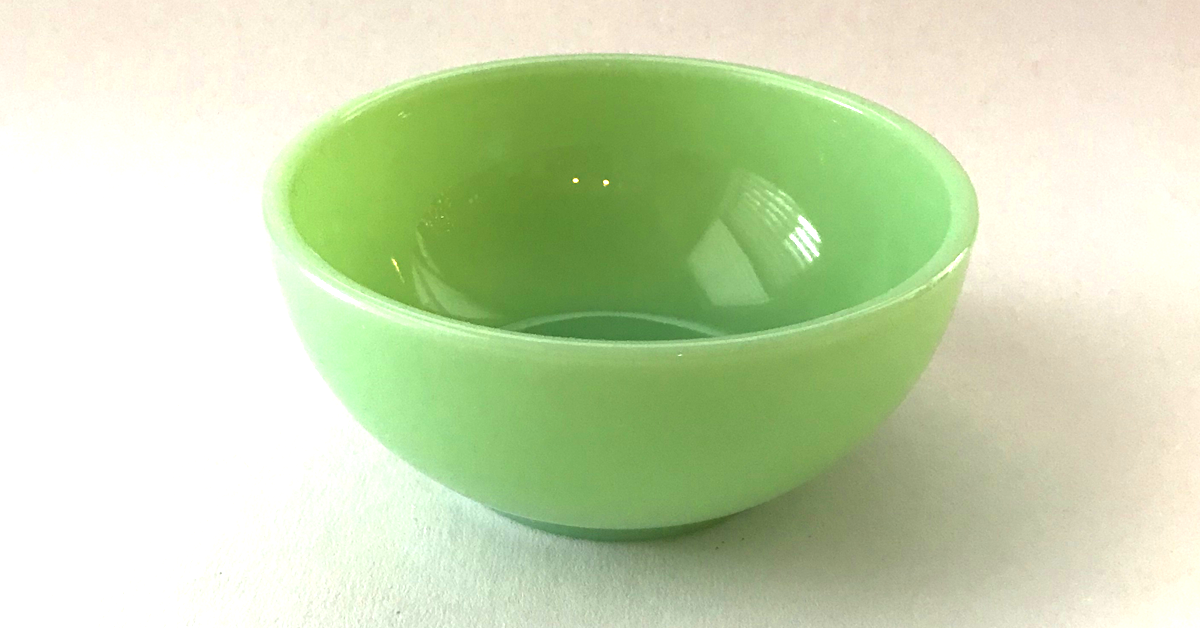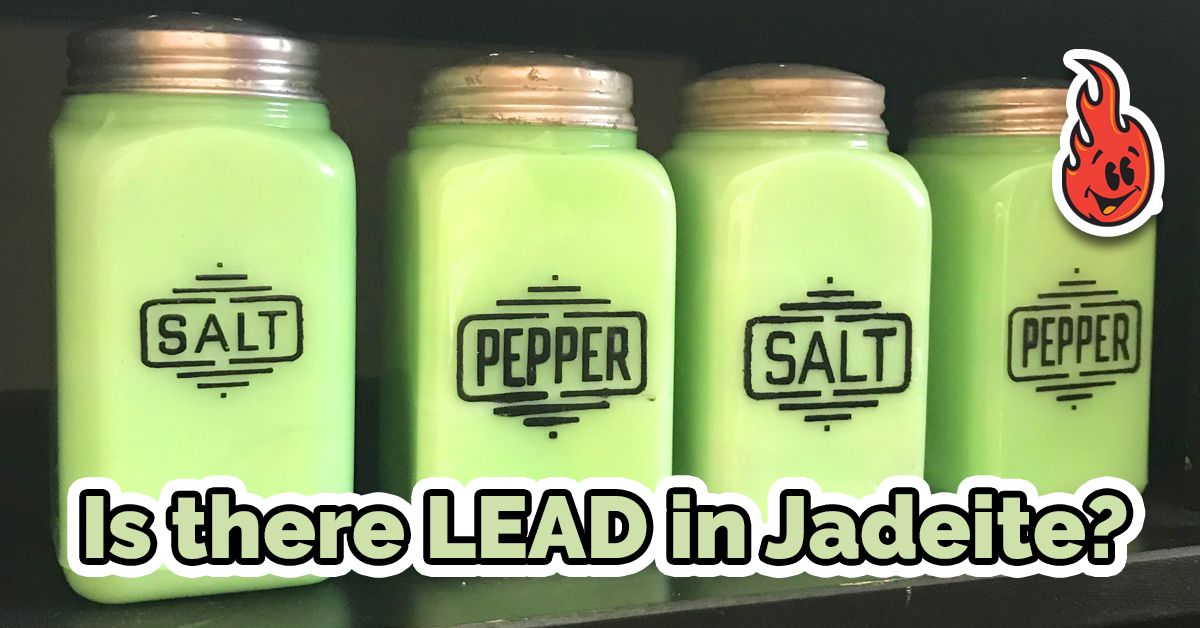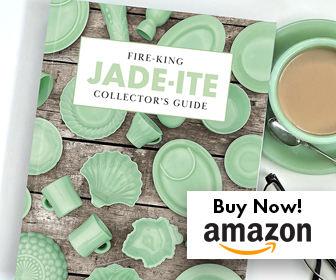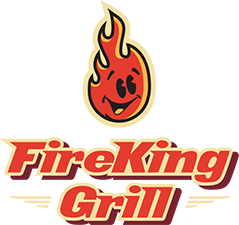Introduction
Are your old Jadeite dishes safe to eat from? That depends on what your risk tolerance is, and how cautious you are to minimize your exposure to lead and other contaminants.
Current Prices for Jadeite Dishes
What is Lead?
Lead is a naturally occurring element, but it can be toxic to humans and animals. Children are especially vulnerable to the effects of lead because their bodies absorb it more readily than adults do. Also, children’s brains and nervous systems are more sensitive to the effects of this substance.
Read more: Q & A About Lead in Tableware, California Department of Public Health
Learn About Lead, United States Environmental Protection Agency
Does Jadeite Contain Lead?
Expert Tamara Rubin, the Lead Safe Mama, uses a scientific method also used by the U.S. Consumer Product Safety Commission to test consumer goods for toxicants.
She tests household items for lead, cadmium, mercury and arsenic using an XRF (X-Ray Fluorescence spectrometry analyzer).

What is Considered a Safe Level of Lead?
Levels below 90 ppm are supposedly considered safe for children. However, we consider this safety recommendation irrelevant, because no level of lead is really safe.
Even though the Fire-King cereal bowl had very low levels, it can’t be assumed that other Fire-King Jadeite would test within a safe range.
Read more: Spooky Stuff! These Jadeite Dishes Glow Under a Black Light
Case in point, see the results for this Anchor Hocking Fire-King Jadeite D-handle mug at Healthy Living: Is Pyrex Poison? Despite the mug testing over the safety limits, the author acknowledges that overall, Jadeite is considered much safer than Pyrex in terms of lead content.
Why Is Lead Added To Dishware?
Lead gives a smooth, glasslike finish to glazes and it allows bright colors and decorative patterns to show through. It augments the brightness of intense colors, which is probably why some of the more richly colored and patterned dishware tests much higher for lead content.
Lead isn’t just found in antiques, and vintage items, but new items too. Companies today are still knowingly manufacturing products with alarmingly high levels of lead, and are getting away with it. Thanks to passionate people like Tamara, her work allows us to explore what’s really in the products we use.
View this post on Instagram
Are Jadeite Dishes Safer Than Dishes You Already Use?
If you have concerns about Jadeite dishes containing lead or other toxins, you should be equally, or perhaps even more concerned about the dishes you’re currently using.
Surprisingly, a lot of new dinnerware, glassware, and kitchenware not only has high lead levels, but also cadmium, which is a known carcinogenic.
Check out The Lead Mama to see her test results on many popular vintage and newer products from Pyrex to Fiestaware. Use the search bar to look up specific companies and patterns.
And be prepared…
According to some of Tamara’s results, not all dinnerware that’s promoted as being lead-free, lives up to that claim.
Pyrex vs Jadeite – What’s Safer?
A lot of Pyrex and Corelle collectors will be surprised to know some of their vintage pieces contain very high levels of lead, primarily on the decorative pattern elements.
I’m not talking about levels that are marginally over what’s considered safe, I’m talking way over the top levels of lead.
Just look at these Pyrex patterns Tamara has tested. Shockingly, Corelle admits their products made prior to 2005 should be used as decorative pieces only.
Corelle was introduced in 1970 by Corning Glass Works, and was the same company that made Pyrex.
View this post on Instagram
Those Beautiful Pyrex Designs Will Fade
To be clear, most of the lead in Pyrex and other vintage glassware is on the outside painted portions of bowls and baking dishes.
So shouldn’t that be okay?
It’s easy to assume that since food doesn’t come in contact with the outside of a bowl or dish, it’s safe to use.
However, regular use such as stacking dishes inside one another, putting them through the dishwasher, and wiping them down, causes lead to be chipped off in microscopic amounts. But even these microscopic amounts are dangerous, and continuous exposure can increase health risks.
There is lead in many household and consumable products, so to focus on Jadeite as such a primary source of exposure would be misleading.
Read more: Common household items containing lead, Department of Health
It’s definitely worth your time to learn about the contaminants in new and vintage dishware.
It’s common to think that using your Pyrex on a daily basis is completely safe, and a better alternative to plastic. I know we used to – it’s glass, right, so why wouldn’t it be?
Is There A Way To Test My Own Dishes For Lead?
Yes. If you want to check the lead levels in the painted surfaces of your dishes. The 3M company makes a product called the 3M LeadCheck Swab, but there are limitations with this product.
The LeadCheck Swab is only designed to test for lead in paint, so it’s ineffective in testing for glass, milk glass, shiny glazes, and plastic. Another serious drawback is the LeadCheck Swab won’t detect lead unless there is a level close to 600 ppm in any paint or painted surfaces. This means that if you test something that has less than 600 ppm, you can expect the reading to be negative.
A negative reading with the LeadCheck Swab isn’t confirmation that whatever painted surface you tested is lead-free, it only means the level is below 600 ppm.
So, potentially, you could have something that reads negative when tested with a LeadCheck Swab, but if that same dish was tested with an XRF, it could read as high as 500+ ppm, and as we’ve already discovered, any level over 90 ppm isn’t within safe limits.
The only reliable way to test for lead in dishware is with an XRF.
Read more: Tamara Rubin: Can I Test My Dishes With A LeadCheck Swab?
View this post on Instagram
Conclusion: Is Jadeite Safe to Use?
There are some sites claiming that all FireKing Jadeite products are completely lead-free, but given Tamara’s test results, we know that’s inaccurate.
Ultimately, you will have to decide what your risk tolerance is for lead and other contaminant levels in your dishware.
We recommend using the information we’ve provided and the information from Tamara’s site Lead Safe Mama to help you make a knowledgeable and informed decision.
Here at Fire-King Grill, we are comfortable using our Fire-King Jadeite dishes regularly, but we use our Pyrex for display and photo-op purposes only.
Let us know in the comments below. Do you use your vintage Pyrex and Jadeite dishes regularly?
Current Prices for Jadeite Dishes
Advertiser Disclosure: Some links on this site are affiliate links. If you click on them and make a purchase, I may earn a commission at no extra cost to you.
Your support helps keep FireKing Grill running. Thank you!




What about Jadeite salt & pepper shakers?
I have Benny jadeite items that I have collected over the years. I mostly use them for show and my glass cupboards, but would like to know how to test them and which would be the best way. I have heard that a UV black light would be effective? Please advise and thank you.
Hi Tracy, a U/V light is great for seeing if your dishes have uranium in them, as they will glow under a black light. This can help determine if they are authentic, but won’t tell you if there’s lead in your dishes.
To test your dishes for lead content, you can purchase a lead test kit from a hardware store and use that instead.
Hope that helps!
I have a vintage Fire King jadeite mixing bowl with a pour spout and handle. About 2 quart size. I use it occasionally when mixing something. I’ve recently become aware of the chemical contents of certain dish ware, and replaced my vintage Corelle and Pyrex. Now my focus is on this jadeite bowl. It belonged to my grandmother, so it is probably from the 1940’s. I like this bowl, it’s easy to use and just the right size. I am hoping that it is safe to use.
Hi Linda, that’s great you’re able to use your grandmother’s Jadeite bowl! We use our Jadeite on a daily basis, as I do believe they are much safer to use than Pyrex and Corelle which uses lead based paint for the designs. As pretty as they are, I feel Pyrex bowls are better left for display, whereas Fire-King Jadeite can be used safely.
I just bought a Fire-King jadeite restaurant mug at a local antique mall and have been trying to see if it’s safe to use—at least for a morning cup of coffee. The bottom says “Oven Fire-King Ware”, which I’ve read indicates likely made in the mid to late 1940s. Once I figured out it wasn’t radioactive, my next question was how much lead does it contain. This article is pretty helpful. Thanks!
Hi Terry, so glad you found it useful! Enjoy your morning coffee in Jadeite!